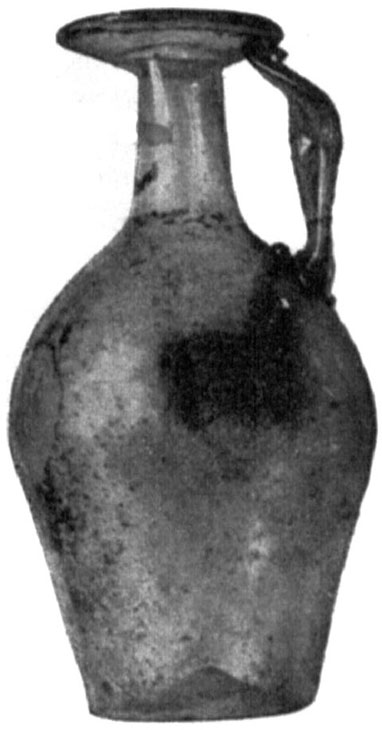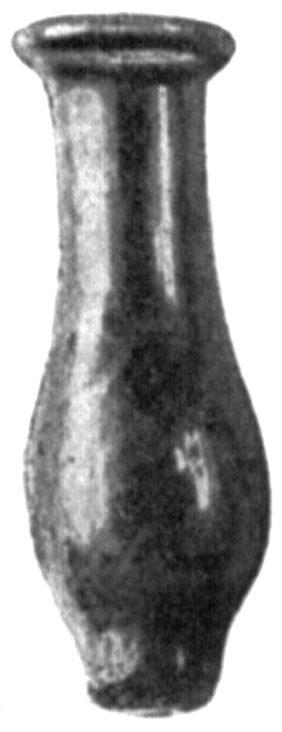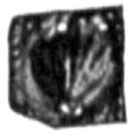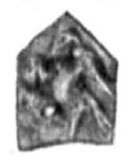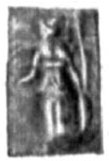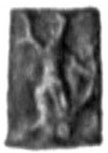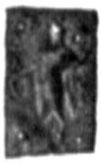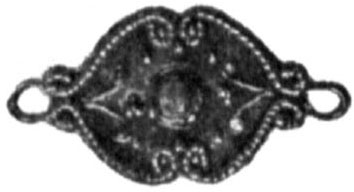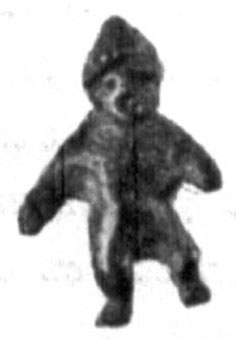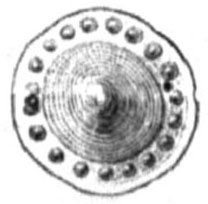 |
 |
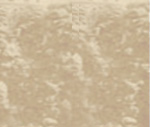 |
|
||
| main :: biography :: texts :: manuscripts :: photographs :: drawings :: squeezes :: publications :: about | ||
|
Excavation in the north-west corner of the ancient city site
The breach in the w<est> defen<sive> wall, in the very corner of it, few sazh<enes> fare from the steep coast, induced Mr Kostsyushko-Valyuzhinich to organize small excavation there with the aim to find the remains of the n<orth> city gate. These works resulted in discovering the gate, as well as a special wall, collapsed at low, laid of dressed slabs, which masked the gate from the n<orth>, from the sea side, as long as 10 arch<ines> and 10 versh<oks>
(fig. 252)
On either side of the defensive wall, there was the same ashlar facing, as in the south-west and south-east areas. Between the gate and the sea, the wall is 11 arch<ines> high; even remains of battlements remained on its top; the wall to the south from the gate is considerably damaged. The ground Д, where the gate was located, is paved with slabs of irregular form: it is sub-floor, though only one slab о remained of the upper, parade flooring. Slabs п and р, the first raised 1 arch<ines> and 14 versh<oks> above the sub-floor, formed facing of the south inner wall. No slabs appeared in с, but the wall plaster in this placed keeps traces of the above; besides that, the sub-floor does not cover this strip, which circumstance proves that there were facing slabs; on the opposite side К , these facing slabs remained at full length of the north inner wall, as can be seen at
fig. 253
. As the short wall В, that has the from of letter Г from the side of the ancient city site
(fig. 254)
), was laid of excellent ashlars (valuable for buildings of every kind), it is quite understandable that only the lower course of its masonry survived, that was covered by collapse, similarly to the facing of the wall А. This wall covered the gate from the sea side [9].
The following finds were uncovered when removing solalpsed soil and stones: fragment of marb<le> ornament of the Byzantine period; crushed earthen<ware> pitcher; cylindrical earthen<ware> sinker for fishing nets, and earthen<ware> circle decorated with radiate cuts.
Continuation of the excavations in the necropolis
1895 investigations uncovered: 2 catacombs (nos. 554 and 575); 3 tombs that were faced with big roof tiles (nos. 542, 543, and 598); 9 tombs that were constructed of dressed slabs (nos. 576, 578, 579, 586, 599, 600, 603, 605, and 609), one of which (no. 599) had gable roof, similarly to that of tomb no. 429; 16 tombs that were carved into bedrock (nos. 544, 549-552, 560-562, 565-571, and 606), including one tomb (no. 544) that had two side niches similarly to tombs nos. 355 and 356; 30 underground tombs, that is the ones where the skeleton, after the wooden coffin decayed, appeared in soil, likely it was faced with fine stones (nos. 545-548, 553, 555-559, 563, 564, 572-574, 580-583, 587-589, 591-593, 597, 601, 602, and 604); 9 earthenware urns uncovered from the mound <********> (nos. 577, 584, 585, 590, 594-596, 607, and 608), and 18 urns (including 3 lead ones), which were in tombs (nos. 578, 579, and 599). The tombs that were faced with big roof tiles with stamps of astynomoi date to the ancient Greek period. These tombs nearly always contained black slip plates with scratched names and monograms, and lead three-fingered pendants.
When the tombs of the Roman period (nos. 578, 579, 586-597 and 599) relied on the wall of the counterscarp for convenience (s<ee> the plan as attached at fig. 255) , tile tomb no. 598 is located aside, which is also an argument for it was constructed earlier than the given wall. There are another artifacts dated to the same period: two grave steles of local sandstone, with Greek inscriptions (s<ee> t<ombs> nos. 579 and 610); fragment of marble statue of woman, of high artistic quality; half of top marble decoration of grave stele, similar to the one uncovered in 1893 (s<ee> the description of tomb no. 426); and one specimen of br<onze> coin of Chersonesos, described in Burachkov's Collection, and published by him at plate XIV, no. 13. Mr Kostsyushko-Valyuzhinich has paid attention to the fact that all the ancient Greek grave steles discovered before were made of local sandstone, sometimes with small marble tablets indicating the names of the deceased, and supposed that the great number of marble details (in A. L. Berthier-Delagarde's opinion, from Proconnesus), uncovered during the excavations of the ancient city site, appeared in Chersonesos no earlier than the Roman period. In the year under report, the excavations of the necropolis continued close to catacomb no. 541, that had been uncovered in 1894 in between of the road and contractor Kuznetsov's barracks. The following tombs were uncovered within this narrow strip: 542. The tomb was faced with big roof tiles and contained skeleton of child. The finds are: 2 br<onze> rings on the forefinger, and 6 beads of blue glass.
543. The same. At the head of the buried person, there was br<onze> coin of autonomous Chersonesos with image of warrior leaning on one knee, wearing pointed cap, with shield and spear, and letters ХЕP on one side, and quadriga driven by coachman with whip in his hand, and letter
544. The tomb was cut into bedrock (7' long, 8' 7" wide and 5' deep), with construction similar to those of tombs nos. 355 and 356), but having not one but two niches, from the north and south sides, the first was 7' long and 4' wide, the second was 7' long and 2' 7" wide. Its central part, 7' long and 2' wide, was the entrance and was blocked with two slabs. It contained skeleton (with the head to w<est>) accompanied by: plain earthen<ware> lamp, iron knife blade <*********>, and br<onze> Bosporan coin, of late period, of bad preservation. The north niche appeared to contain skeleton as well, with the head oriented to w<est>, accompanied with g<old> impression of coin with unidentifiable image and bead of multicolored paste. 545. This underground tomb contained skeleton accompanied by 3 gl<ass> beads and br<onze> coin of Cherson<esos> (Burachk<ov, op. cit., plate> XVI, 96, but of the other type and with star in front of the head). 546. Underground tomb with child's burial accompanied with 2 br<onze> bracelets, single-handled earthen<ware> juglet, and br<onze> coin of Cherson<esos> (Bur<achkov, op. cit., plate> XVI, 108).
547. The same. The finds: br<onze> bracelet, amber bead, 3 gray paste beads, and single-handled earthen<ware> juglet. 548. The same, with single-handled earthenware juglet, earthen<ware> cup, and bronze coin of Chersonesos (Bur<achkov, op. cit., plate> XVI, 96). Worker's barracks located in this area forced us to transfer the excavations to the west side of the defensive wall; for convenience, the excavations started at the round flanking tower that was located near the northern city gate discovered in 1893. This necropolis area appeared to include 13 tombs that were carved into bedrock, 11 underg<round> tombs, and 2 catacombs. 549. The tomb was cut into bedrock (3 arch<ines> long, 13 versh<oks> wide, and 12 versh<oks> d<eep>). There were no accompaniments to the skeleton. 550. The same. 2 ½ х 1 х ¾. The skeleton was accompanied by br<onze> unreadable colonial coin. 551. The same. 2 х 1 х ¾ arch<ines>. Earthen<ware> lamp with relief leaf on its handle (fig. 256) and earthen<ware> saucer with high foot. 552. The same. 2 х 1 х ¾ arch<ines>. There were no accompaniments to the skeleton. 553. Underg<round> tomb with 2 skeletons. It contained: gl<ass> round-bottom bottle; br<onze> bracelet terminating in snake's heads; saucer under red slip; 3 pierced beads of green paste, in the form of laying lions; 5 scarabs of green, yellow, and gray paste with dolphin impressed from below; chalcedonic amphora-shaped pendant; 5 rock crystal beads; 2 chalcedonic beads; 5 beads of green and yellow paste; 4 jet beads, and 2 glass beads. 554. This square catacomb (3 х 3 arch<ines> at the base, 2 arch<ines> and 11 versh<oks> high) has three niches (1 arch<ine> and 3 versh<oks> w<ide> and 1 arch<ine> h<igh>). There is a passage from the w<est>; it was blocked with stone slab. The layer of soil that filled the catacomb almost reached the niches, and on top of it, there were 5 articulated skeletons, with the heads towards the entrance, without pottery or artifacts. It is clear that this burial dates to the later period, it was arranged in the ancient catacomb, semi-covered with soil. 555-559. Five undergr<ound> catacombs; first 3 monuments appeared to be plundered, and 2 other contained 2 single-h<andled> earthen<ware> juglets, and single-h<andled> earthen<ware> cup. 560-562. Three tombs were cut into bedrock (3 х ¾ х ½ arch<ines>; 3 ? arch<ines> x 14 versh<oks> х ½ arch<ines>, and 3 ¼ arch<ines> х 14 versh<oks> х 10 versh<oks>); neither pottery nor artifacts were found at the skeletons. 563. This underg<round> tomb contained: gl<ass> balsamarium; single-handled earthen<ware> juglet; single-hand<led> earthen<ware> cup, and amber bead. 564. The same. Single-hand<led> earthen<ware> juglet; plain earthen<ware> lamp; grinding stone; iron knife blade; br<onze> belt buckle, and br<onze> bracelet. 565. The tomb was carved into bedrock; it is 2 ¼ х ¾ arch<ines> х 6 v<ershoks>. There were no accompaniments to the skeleton. 566. The same, 2 arch<ines> and 6 versh<oks> х 13 v<ershoks> х 8 v<ershoks>. Single-hand<led> earthen<ware> juglet; 2 g<old> w<ire> earrings; bron<ze> wire brooch; 5 beads of multicolored paste; 2 glass beads; 2 amber beads, and 3 jet beads. 567. The same, 2 arch<ines> and 6 versh<oks> х 13 v<ershoks> х 7 v<ershoks>. Although no traces of plunder were discovered, the skeleton appeared to be accompanied by neither pottery nor artifacts. 568. The same, 3 arch<ines> х 1 arch<ines> and 6 v<ershoks> х 6 v<ershoks>. G<old> earring in the form of twisted cord, decorated with oval garnet; g<old> child's finger-ring with garnet, with dog running to the left carved into it; 2 small bells of thin g<old> badge; 3 gl<ass> balsamaria; 2 whetstones; 2 iron knife blades; 2 bron<ze> bracelets with snake's heads on either end; single-h<andled> earthen<ware> juglet; 2 plain earthen<ware> lamps; earthen<ware> bowl; 3 carnel<ian> amphora-shaped pendants; rock-crystal amphora-shaped pendant; 2 round ribbed and 2 flat oval beads of rock crystal; 7 carnel<ian> beads (1 faceted, 2 circular and 4 elongated).
569-571. The same, 2 arch<ines> and 10 versh<oks> х 10 v<ershoks> х 10 v<ershoks>, 3 х ¾ a<rchines> х ¾ a<rch<ines> and 2 ¾ a<rch<ines> х 14 v<ershoks> х 8 v<ershoks>. Similar to tombs no. 549, 552, 560-562, 565 and 567, these ones appeared to contain neither pottery, nor coins or artifacts. 572. This underg<round> tomb contained: single-h<andled> earthen<ware> juglet; earthen<ware> bowl; gl<ass> balsamarium; 6 jet beads; carn<elian> bead, and bead of multicolored paste. 573. The same; bron<ze> brooch and bracelet of thick bron<ze> wire that is winded around with thinner wire. 574. The same; the skeleton appeared to be accompanied by neither pottery nor artifacts. 575. The catacomb was 6' 7" long, 6' 5" wide, and 5' 5" high, it has three niches 3' w<ide> and 2' 9" h<igh>. The passage looks to the e<ast>. The bones were found in disorder on the floor, without pottery or artifacts. The finds from the mound above this area of the necropolis are as below: red slip plate with inscription TICXAXOC scratched from below; earthen<ware> lamp with relief image of dog attacking wild boar, and bone hair pin (fig. 257) , top part of which consists of female figure (the head is missing). In the direction opposite to the above excavations, along the outer side of the w<est> defensive wall, excavations were made starting from tomb no. 429, that is from the point where 1894 excavations had stopped (s<ee> fig. 258) . Tombs in this necropolis area supplied more valuable finds.
576. The tomb is laid of stone slabs; it is 8' long, 6' wide, and 3' deep, with the entrance from the s<outh>, located 4 arch<ines> far from tomb no. 429; its east wall annexes the defen<sive> wall. Within the tomb, there are 8 quadrangular niches (9 v<ershoks> hide, 7 v<ershoks> wide, and 9 v<ershoks> deep): 5 in its w<est> side and 3 in the n<orth> side. Slabs that covered the tomb originally were missing, which is why the tomb was filled with soil that crushed earthen<ware> urns with ashes. The following finds are made in the soil when removed and sieved: 19 g<old> sewing badges, 9 of which are circular, in the form of pointed caps, 5 star-shaped, 1 elongated quadrangular, with woman's head facing right (fig. 259) and 4 rhombic, with hemispheres pressed into the surface (fig. 260) ;
 pressed into its bottom;
7 earthen<ware> lamps with relief images: of sitting man, inclined (shepherd?), with long staff with hook laying at his foot on the first lamp
(fig. 262)
, running Eros on the second, eagle on the 3-rd and 4-th, heron on the 5-th
(fig. 263)
,Pegasus on the 6-th, and warrior on the 7-th; 4 plain earthen<ware> lamps; 3 gl<ass> flat-bottom balsamaria; spouted gl<ass> bottle; blue glass jar; glass gem for finger-ring with carved figure of standing woman; 5 earthen<ware> juglets; 6 single-handled earthen<ware> cups; handleless earthen<ware> cup; earthen<ware> bowl; 2 earthen<ware> saucers; br<onze> openwork brooch formed by 4 triangles of one square, with 4-point star in the middle and traces of multicolored enamel on the triangles and the star
(fig. 264)
; gl<ass> finger-ring; gl<ass> ring; 3 br<onze> bracelets; twisted gl<ass> stick with gl<ass> ring on one end; chiseled b<one> clasp; b<one> handle for small bell; silv<er> ear spoon; br<onze> tongs; br<onze> key with ring; 2 knobbed br<onze> rings; 8 olive pits with cut in the middle; piece of red paint; piece of sulfur; chalcedonic amphora-shaped pendant; beads of rock-crystal, carnelian, chalcedony, coral, amber, jet, multicolored paste, and glass; br<onze> coins of Cherson<esos> (Bur<achkov, op. cit., plate> XVI, 91, 104, 108, and 114); 2 br<onze> coins of Agrippia, and 2 bronze coins of the emperor Maximinus (235-238), of excellent preservation. pressed into its bottom;
7 earthen<ware> lamps with relief images: of sitting man, inclined (shepherd?), with long staff with hook laying at his foot on the first lamp
(fig. 262)
, running Eros on the second, eagle on the 3-rd and 4-th, heron on the 5-th
(fig. 263)
,Pegasus on the 6-th, and warrior on the 7-th; 4 plain earthen<ware> lamps; 3 gl<ass> flat-bottom balsamaria; spouted gl<ass> bottle; blue glass jar; glass gem for finger-ring with carved figure of standing woman; 5 earthen<ware> juglets; 6 single-handled earthen<ware> cups; handleless earthen<ware> cup; earthen<ware> bowl; 2 earthen<ware> saucers; br<onze> openwork brooch formed by 4 triangles of one square, with 4-point star in the middle and traces of multicolored enamel on the triangles and the star
(fig. 264)
; gl<ass> finger-ring; gl<ass> ring; 3 br<onze> bracelets; twisted gl<ass> stick with gl<ass> ring on one end; chiseled b<one> clasp; b<one> handle for small bell; silv<er> ear spoon; br<onze> tongs; br<onze> key with ring; 2 knobbed br<onze> rings; 8 olive pits with cut in the middle; piece of red paint; piece of sulfur; chalcedonic amphora-shaped pendant; beads of rock-crystal, carnelian, chalcedony, coral, amber, jet, multicolored paste, and glass; br<onze> coins of Cherson<esos> (Bur<achkov, op. cit., plate> XVI, 91, 104, 108, and 114); 2 br<onze> coins of Agrippia, and 2 bronze coins of the emperor Maximinus (235-238), of excellent preservation.
577. Single-handled earthen<ware> urn (cr<ushed>) was located at the very defensive wall; besides cremated bones, it contained: 2 pieces of thin sh<eet> gold; br<onze> brooch; iron knife blade, and st<one> hone. 578. The tomb was laid of stone slabs (2 ¼ arch<ines> х 14 v<ershoks> х 12 v<ershoks>); it is located 4 ⅓ sazh<enes> far to the w<est> from the defen<sive> wall. It contained: 3 single-handled earthen<ware> urns (2 were crushed) and 1 lead urn; the following artifacts were taken from the latter, apart from cremated bones: 2 pieces of thin sheet gold, and glass flat-bottomed balsamarium, though earthen<ware> urns appeared to contain: 10 pieces of thin sheet gold; gold w<ire> earring; silv<er> finger-ring with carnelian gem with carved image of hum<an> figure stepping left; br<onze> toothed bracelet; silv<er> casket detail; iron knife blade; 3 gl<ass> flat-bot<tomed> balsamaria; round bead of rock crystal; 5 ribbed beads of green paste; elongated glass-shard bead, and br<onze> coin of Cherson<esos> (Bur<achkov, op. cit., plate> XVI, 103)
579. The same (6 arch<ines> х 14 v<ershoks> х 12 v<ershoks>); it was located close to the previous one, to the south; it west side adjoins the wall of counterscarp, which goes here 5 sazh<enes> far from the def<ensive> wall. It appeared to contain 5 earthen<ware> urns (1 single-handled, with scratched name
580. Underg<round> tomb contained: 2 small br<onze> spades (coroplast's tools?); slab of pink marble with white streaks (4" х 2" ½), with the borders aslant on one side [10]. 581. The same; the finds: 2 eathen<ware> bottles; br<onze> brooch; br<onze> belt buckle; 3 pendants of green paste in the form of phallus, scarab, and amphora; 13 beads, 1 of which is of rock crystal, 2 of yellow paste, and 10 of multicolored glass. 582. The same; single-handled eathen<ware> juglet, that contained br<onze> needle and br<onze> coin of Cherson<esos> (Bur<achkov, op. cit., plate> XVI, 104). 583. The same; the finds: 20 beads, 3 of which are of carnelian, 4 of amber, 1 of jet, 1 of green paste, ribbed, and 11 of multicolored glass. 584. Earthenware urn (crushed). Apart from the remains, it contained: 2 g<old> sewing badges, one in the form of pointed cap, another star-shaped; 3 pieces of thin sheet gold; glass bottle, and bronze brooch. 585. The same; the finds: double-handled earthenware urn, that appeared to contain cremated bones and 3 pieces of thin sheet gold and glass flat-bottom balsamarium.
586. This laid of stone slabs tomb (2 ½ a<rchines> х 14 v<ershoks> х 11 v<ershoks>) was plundered. The soil removed from the grave contained: gold pendant with eyelet, in the form of pail, with soldered gold wire scroll (fig. 268) ; gold sewing star; silv<er> wire earring; knobbed br<onze> ring; iron knife blade; 6 jet beads; br<onze> coin of Cherson<esos>, very rare, but badly preserved, with countermark in the form of standing Artemis (s<ee> Burachkov, <op. cit., plate> XVI, 99; he reproduced the inscription incorrectly due to the bad preservation of the coin). 587. This under<ground> tomb contained red slip plate and 30 beads of green glass.
588. The same; the finds: spouted earthen<ware> vessel with single handle; gl<ass> decanter-shaped bottle (fig. 269) bear's (?) tooth with hole for hanging; 4 ribbed beads of green paste; 1 jet bead and 6 glass beads. 589. The same. The finds: earthen<ware> lamp with relief image of dog attacking wild boar; 2 pendants (one of green paste, in the form of phallus, and the other of blue glass, scarab-shaped); 2 rock crystal beads; 1 amber <bead> [11], 1 jet <bead>, and 52 <beads> of multic<olored> glass. 590. Earthen<ware> urn (crushed). The finds: star-shaped gol<d> badge; 3 pieces of thin sh<eet> gold, and bron<ze> bracelet. 591. Undergr<ound> tomb. The finds: broken gl<ass> balsamarium; 5 green paste pendants, two of which in the form of clumsy hum<an> figures (fig. 270) ; 2 in the form of bunches of grapes, and 1 amphora-shaped; gl<ass> knucklebone on silv<er> wire; 3 bron<ze> knobbed rings; 23 beads (1 of chalcedony, 2 of r<ock> crystal, 6 of carnelian, 8 of jet, and 7 of glass). 592. The same. The finds: earthen<ware> bottle; earthen<ware> lamp with relief image of rosette (fig. 271) and name ROMANESIS on the bottom (s<ee> tomb no. 579). 593. The same. It contained: ribbed, handleless earthen<ware> cup; round-bottom gl<ass> balsamarium (broken); 2 pendants of green paste (one hand-shaped, another scarab-shaped); 6 amber beads (s<ee> the note to <the description of tomb> no. 589), and 12 glass beads which were stringed on a cord. 594-596. Three earthen<ware> urns (crus<hed>) were located nearby. Apart from cremated bones, these contained: 6 pieces of thin sh<eet> gold, gl<ass> flat-bottom balsamarium, and whetstone, damaged by fire. 597. Under<ground> tomb, in which there were: single-handled earthen<ware> juglet, and iron knife blade.
598. This tomb was faced with big roof tiles, 4 of which remained intact. There is stamp with the name of astynomos:
599. This tomb was laid of stone slabs, with gable roof, similarly to that of tomb no. 429, which was discovered in the same area, 15 sazh<enes> far to south-east. The tomb is 3 arch<ines> and 9 v<ershoks> long, 2 arch<ines> and 15 v<ershoks> wide, with the roof as high as 1 arch<ine> and 13 v<ershoks>, its maximum height in the middle is 2 arch<ines> and 7 v<ershoks>, the slabs are 9-10 v<ershoks> thick, the entrance is 15 v<ershoks> wide at the north side and 1 arch<ine> and 3 v<ershoks> high, and the earth layer above the tomb is as much as 2 arch<ines> and 2 v<ershoks> thick. There are rectangular niches in either wall inside the tomb. The number of the above niches is: 4 in the east wall, which is to the left from the entrance; it the south wall, opposite to the entrance, 4 below and 1 above; 1 in the right, western wall; 1 in the north wall, where the entrance is located, 11 niches total. The entrance to the tomb is closely blocked with slab; when the slab is removed, the following situation appeared: on the floor, there were well-preserved boards of three coffins, carefully matched with wooden rabbets and cleared by plane that left double parallel deepened track on either edge. Here, fragments of brown woolen cloth and multitude of leaves, probably laurel, were scattered. The skeletons are completely rotten. There were 3 single-handled earthen<ware> urns with earthenware lids fixed with lime standing at the western wall, and, in different places on the floor, gl<ass> and earthen<ware> pottery: gl<ass> bottle with twisted handle, similar to the one uncovered in 1890, in tomb no. 9 (fig. 272); gl<ass> bottle with wide base (fig. 273) ; 1 gl<ass> bottle with narrow bottom and 3 gl<ass> bottles with round bottoms; blue glass cask; 11 gl<ass> flat-bottomed balsamaria;
5 single-handled earthen<ware> juglets; earthen<ware> juglet with two handles; single-handled earthen<ware> juglet, with the neck compressed on top like rosette; single-handled earthen<ware> cup; spoon-shaped handleless earthen<ware> cup; 3 red slip saucers; 12 earthen<ware> lamps with relief images of Helios, Eros (2 spec<imes>), man holding goat by horns, two naked women inclining to bowl, one pouring liquid from vessel, deer, dog (2 spec<imens>), heron, shell, star, rosette; 13 plain earthen<ware> lamps. The footing of the tomb was covered with thin layer of soil; it was sieved to reveal more finds: 3 whetstones; 2 iron knife blades; iron athlete's scraper (broken into pieces); 2 br<onze> belt buckles; 2 br<onze> bracelets (damaged); 3 round br<onze> mirrors; 5 br<onze> coins, one of which is Greek, with countermark in the form of caduceus, and 4 of Chersonesos (Bur<achkov, op. cit., plate> XVI, 90, but with the year НО, that is 78, or AD 53-54; Bur<achkov, op. cit., plate> XVI. 91, 2 spec<imens>, and Bur<achkov, op. cit., plate> XVI, 96, but with the head facing left [12]; amphora-shaped pendants of rock crystal; 2 green paste pendants in the form of human heads; a number of beads (6 chalcedonic, 3 rock crystal, 40 carnelian, 6 green paste, 10 red paste, similar to the ones discovered in 1891, in catacomb no. 23, 6 of multicolored paste, 1 glass shard, 42 jet, 11 amber, and 54 of multicolored glass); 72 g<old> sewing badges, 15 of which in the form of pointed caps, 16 in the form of plain hemispheres, 23 star-shaped, 6 shell-shaped (fig. 274, 275, 276, 277) , 1 leaf-shaped (fig. 278) , 1 with round boss in the middle, 2 flower-shaped, 1 with image of bird (fig. 279) , 2 with figure of warrior (fig. 280) , 4 with image of Artemis (?) armed with bow (fig. 281) and 1 with image of standing woman (fig. 282) ; gold child's finger-ring with round glass; g<old> wire earring; g<old> earring with rings, similar to the one discovered in 1891 in tomb no. 38 (fig. 283) ; 3 g<old> beads in the form of ribbed tubes, soldered together, similar to the ones uncovered in 1892 in tomb no. 79; g<old> ribbed tube with eyelet, to which small gold bell was hanged; pendant in the form of two gold pails with hoop handles, soldered together (fig. 284) ; 3 pendants in the form of small egg-shaped plain garnets, within frame with eyelet (cf. 1891 Otch<ёt> Arkh<eologicheskoy> Kom<issii> [Archaeological Commission report], p. 143, fig.163 and 170); similar pendant with 2 eyelets and unidentifiable carving on garnet; round g<old> badge with eyelet, with impressed image of woman holding amphora and cornucopia; pendant of g<old> plaque, decorated with granulation, 1 big and 4 small round glasses, and 2 eyelets on the opposite ends (fig. 285) ; gold pendant in the form of amphora on base with 4 balls, decorated with granulation and glass, and provided with eyelet on top (fig. 286) .
1st, 2nd, and 3rd niches in the east wall and 3rd niche of the south wall each contained 1 single-handled earthenware urn with clay plug mortared in with lime, though 2nd niche and top niche in the south wall each contained 1 lead urn (3 earthenware and both lead urns suffered a lot because o dampness). The finds from these 6 urns and 3 urns described above include, apart from cremated bones: 25 g<old> sewing badges, 13 of which have the form of pointed caps, 6 are in the form of plain hemispheres, 4 are star-shaped, 1 shell-shaped, and 1 circular, with female figure pressed into it; 96 pieces of thin sheet gold (48 of these were in one lead urn); chiseled b<one> box; 4 br<onze> brooches; 2 ir<on> athlete's scrapers; 2 br<onze> belt buckles; 2 iron knife blades; whetstone; 8 green paste beads, and 6 knucklebones that were in the urn with cremated bones of child. Top slab in the north-west corner was moved away, which is why some soil penetrated into the tomb. When two-archines-deep layer of soil was removed from above the tomb, it appeared that the corner of it had been damaged when they had built pottery water pipes there. This discovery allows one to argue that the water pipe was arranged after the tomb had been constructed, that is to say, after the end of the first century AD, though the city wall had been erected earlier than the tomb, as tomb no. 429, simultaneous with it, was located only 1 arch<ines> far from the defensive wall and would undoubtedly be destroyed if the wall was built in the period when the tomb existed in this place.
600. The tomb was laid of stone slabs (3 arch<ines> х 1 arch<ines> and 9 v<ershoks> х 15 versh<oks>), without top cover, which is why it was filled with soil and stone. The finds from the soil, removed and sieved, were as follows: g<old> child's finger-ring with round convex garnet, with image of egg carved into it; g<old> wire earring; circular g<old> badge with 2 eyelets and impressed image of woman's head; 4 g<old> sewing badge; silver oval badge (greatly damaged), with impressed in high relief image of Heracles with club and wearing lion's skin [13]; br<onze> pendant in the form of naked figure of man, wearing pointed cap (fig. 287) ; 3 pendants of green paste, 2 of which are in the form of phallus and 1 in the form of amphora; 5 carnelian bead; 3 beads of milky colored stone; 3 amber beads; 12 ribbed beads of green paste; 20 beads of multicolored paste; br<onze> bracelet; bronze brooch; br<onze> belt buckle; knobbed br<onze> ring; 4 gl<ass> balsamaria (2 of these have flat bottom and 2 have round bottom); 4 earthen<ware> bottles; earthen<ware> vessel with one handle and spout; earthen<ware> goblet (?); 2 plain earthen<ware> lamps; 3 earthen<ware> lamps with relief images: of bird sitting on branch of pomegranate on one lamp, Eros on the other, and eagle on the third one; chiseled bone casket, without lid, and br<onze> coin of Cherson<esos> (Bur<achkov, op. cit., plate> XVI, 90). 601. Under<ground> tomb with skeleton of a child. It contained: 3 gl<ass> flat-bottom balsamaria (crus<hed>); br<onze> bracelet and b<one> handle of a small bell. 602. The same. It contained: earthen<ware> bowl; br<onze> bracelet; knobbed br<onze> ring; small br<onze> bell; 4 glass beads; 1 amber bead; 1 jet bead, and 2 carnelian beads. 603. This laid of stone slabs tomb was destroyed and filled with soil and stone. It contained: 2 earthen<ware> lamps with rel<ief> image of cock; plain earthen<ware> lamp; br<onze> bracelet; br<onze> belt buckle; 2 oval pendants of green paste, with rel<ief> image of hum<an> head; j<et> pendant in the form of double-axe; knucklebone-shaped gl<ass> pendant, and several beads (6 of amber, 6 of green paste, 8 of jet, 1 of coral, 28 of multicolored glass, 4 of carnelian). 604. Underg<round> tomb; it contained: earthen<ware> lamp with rel<ief> image of shell; earthen<ware> single-handled j<ug>, and br<onze> coin of Cherson<esos> (Bur<achkov, op. cit., plate> XVI, 108).
605. This laid of stone slabs tomb (3 arch<ines> and 6 v<ershoks> х 1 arch<ine> and 5 v<ershoks> х 15 v<ershoks>) was destroyed and covered with soil, similar to tomb no. 603. The finds: earthen<ware> lamp with rel<ief> image of peacock, sitting upon a tree and pecking at fruits (fig. 288) ; 2 plain earthen<ware> lamps; glass round-bottomed balsamarium; earthen<ware> handleless cup; earthen<ware> saucer; drilled-through shell; br<onze> bird-shaped pendant; chiseled bone box (broken into pieces); drilled-through bone circle; plain oval carnelian gem from finger-ring; round glass, also from finger-ring; pierced bead of green paste, in the form of scarab; 93 beads, namely: 1 of chalcedony, 30 of carnelian, 10 of jet, 4 of amber, 4 of multicolored paste, 12 of green paste, and 32 of multicolored glass; 2 br<onze> coins of Cherson<esos> (Bur<achkov, op. cit., plate> XVI, 91 and 96, but with star in front of the head, and of bigger size). 606. The tomb was carved into bedrock under tomb no. 605. There was rotten skeleton placed with the head to the w<est>; at the head, there were gl<ass> bottle and earthen<ware> vessel; at the waist, there were fragments of br<onze> box; 4 br<onze> coins: 2 of Chersonesos (Bur<achkov, op. cit., plate> XVI, 115), 1 from Panticapaeum (Bur<achkov, op. cit., plate> XXI, 134), and 1 worn-off, with 2 star-shaped countermarks; iron knife blade. 20 knucklebones were scattered at various places within the tomb. 607. Single-handled earthen<ware> urn (crus<hed>). It contained: bone stick for small bell; gl<ass> round-bottom balsamarium (cr<ushed>); bead of multicolored pate, and 3 pieces of thin sh<eet> gold. 608. The same. The urn contained knife blade and 2 pieces of sheet gold.
609. This laid of stone slabs tomb is destroyed and filled with soil and stone; it contained: g<old> earring in the form of twisted cord, with lion's head on the end and oval medallion, with inserted convex garnet; g<old> ribbed tube with an eyelet; finger-ring of semi-opal; 13 g<old> sewing badges, 7 of which are in the form of pointed cap (fig. 289) and 6 are rhombic, with hemisphere in the middle; g<old> quadrangular badge with broken image; 3 pendants (1 of amber, axe-shaped, 1 of jet, pick-shaped, 1 of green paste, hand-shaped); gl<ass> flat-bottom balsamarium; silver child's bracelet; fragment of chiseled bone box; silver spoon; earthenware lamp with relief image of dog standing on lectus; plain earthenware lamp; 52 beads (10 amber, 6 jet, 13 carnelian, 1 chalcedonic, 22 of multicolored glass).
610. This underground tomb contained two skeletons (of a woman and a child), accompanied with: earthenware lamp with relief image of horned human face en face; 2 plain earthenware lamps (there was br<onze> Roman coin portraying the bust of Antoninus Pius laying on one lamp); 2 br<onze> bracelets; br<onze> mirror; br<onze> finger-ring with round glass; shell with a hole; 3 pendants (1 carnelian, amphora-shaped, 1 of rock crystal, in the form of pyramid, 1 of amethyst); 4 amphora pendants (2 of rock crystal and 2 of glass); 1 amber bead; 10 carnelian beads; 1 rock crystal bead; 15 beads of white layer of flint; 12 beads of green pate; 16 jet beads, and 11 beads of multicolored glass.
The soil, cinder and gravel of the mound covering the graves contained: broken into pieces marble head of woman (5" h<igh>), that was sculptured separately and fastened to the body by iron rod; fragment of another marble statue of woman, of very good workmanship (draped bottom part of standing woman, 1' 5" high, the legs are missing); half of m<arble> decoration for grave stele, which image is absolutely the same as that of the decoration covering child's tomb no. 426; child's gravestone of sandstone (similar to the one depicted in 1891 Otchёt Arkh<eologicheskoy> Kom<issii> [Archaeological Commission report], p<age> 18, no. 10); top part of gravestone of sandstone, in the form of stele (1'.6" х 9" х 6"), with two lines of Greek inscription
(fig. 290)
, placed within depression (this stele is decorated with pediment on top, two rosettes on both sides, and, below the inscription, two more rosettes, unbent bow and sword between the bow and bowstring, alike the stele represented in 1892 Otchёt [Report], p. 109, cat. no. 66); 10 pottery water pipes (3 ½ - 4" in diameter), laid above tomb no. 599; half of stone hammer; red slip plate with letters Ф A P scratched on its bottom; 6 gl<ass> balsamaria; 5 single-handled earthen<ware> juglets; earthen<ware> narrow-neck vessel; single-handled cup; 4 earthen<ware> lamps with rel<ief> images: one with dog attacking wild boar, another with bull, the third with dolphin, the forth with human head en face, with horns; 2 plain earthen<ware> lamps; ir<on> blade of knife; gold bead; br<onze> herma-shaped pendant; br<onze> coins: from Olbia (Bur<achkov, op. cit., plate> VII, 162, p. 69, cat. no. 201), Caucasian Caesarea (Bur<achkov, op. cit., plate> XXIII, 1е), Agrippia (Bur<achkov, op. cit., plate> XXIII, 1f), Panticapaeum, of the time of Cotys I (with busts of Claudius and Agrippina), Sinope, Metaponto (according to 3 ears of wheat); 2 c<oins> of unknown Gr<eek> colonies; 3 unreadable colonial coins; 8 coins of Cher<sonesos> (Bur<achkov, op. cit., plate> XIV, 13; XVI, 90; XVI, 91, 2 spec<imens>; XVI, 103; XVI, 104; XVI, 105, and XVI, 116); 3 Roman c<oins> (one with bust of unknown empress, another possibly of one of the sons of Constantine the Great, the third one of Theodosius the Great).
|
|||||||||||||||||||||||||||||||||||||||||||||||||||||||||||||||||||||||||||||||||||||||||
| ©National Preserve of Tauric Chersonesos . 2007 - 2025 |
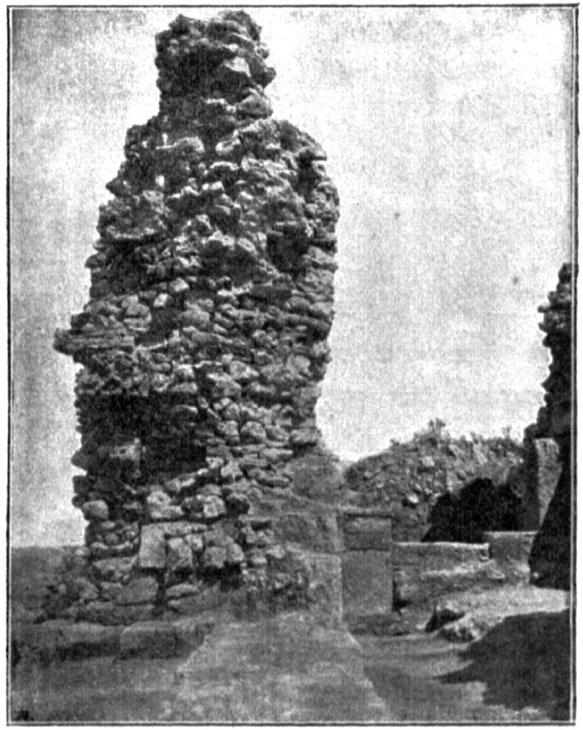
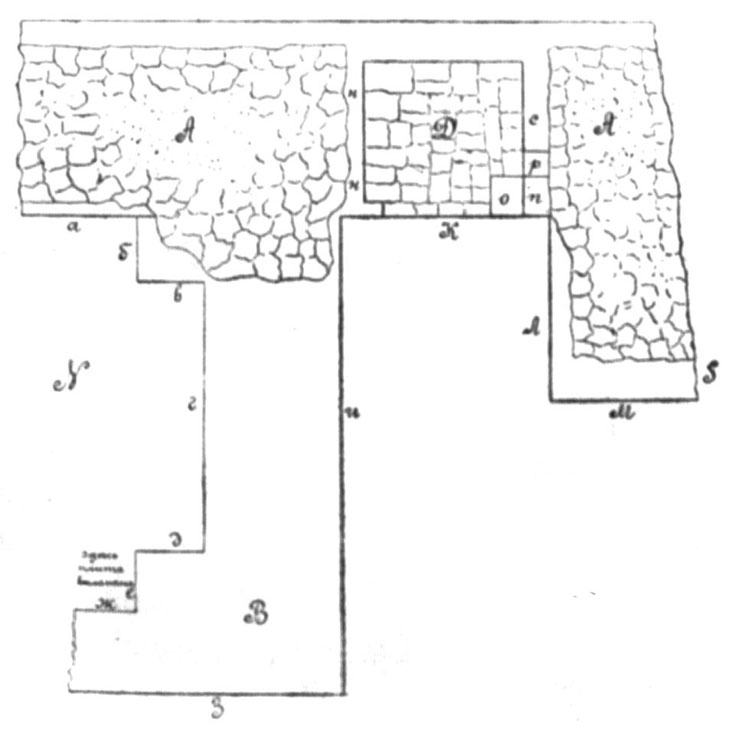
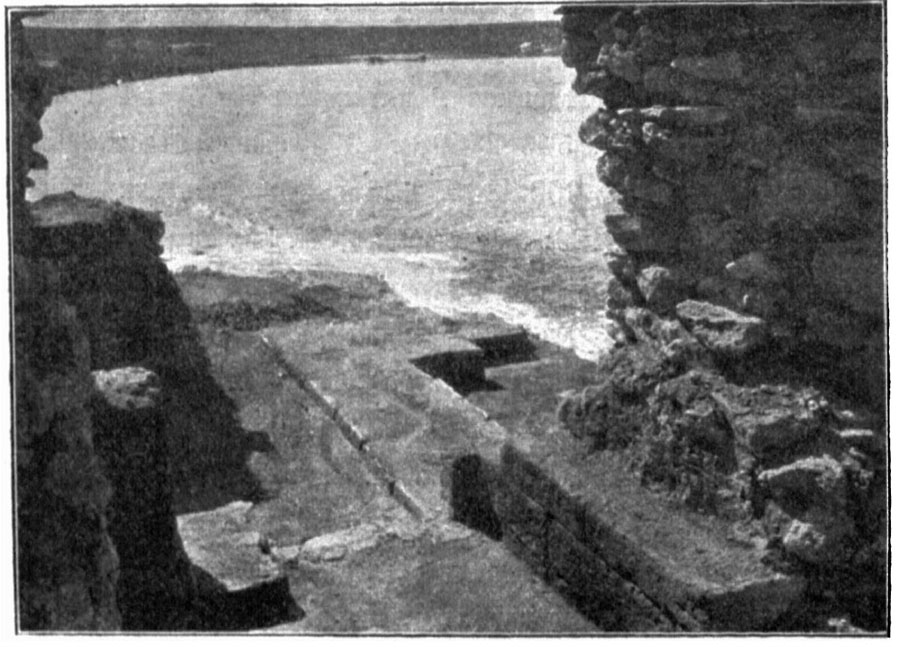
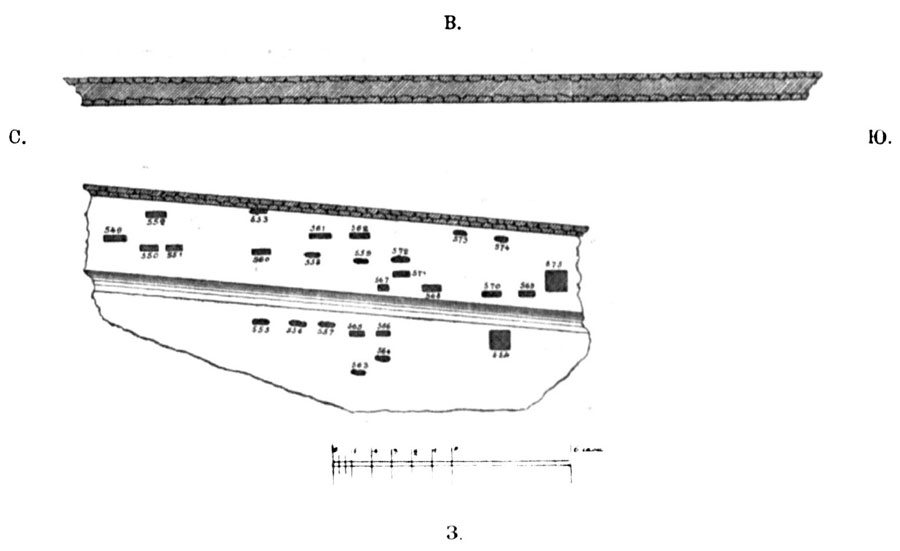
 above, on the other side. S<ee> Burachkov's work, pl. XV, no. 68.
above, on the other side. S<ee> Burachkov's work, pl. XV, no. 68.
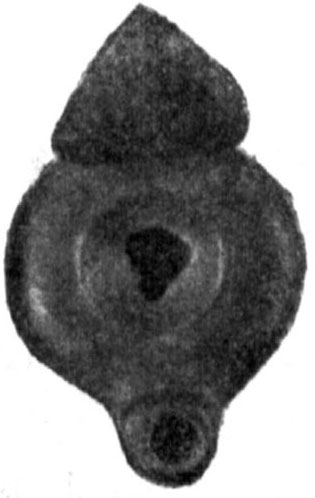

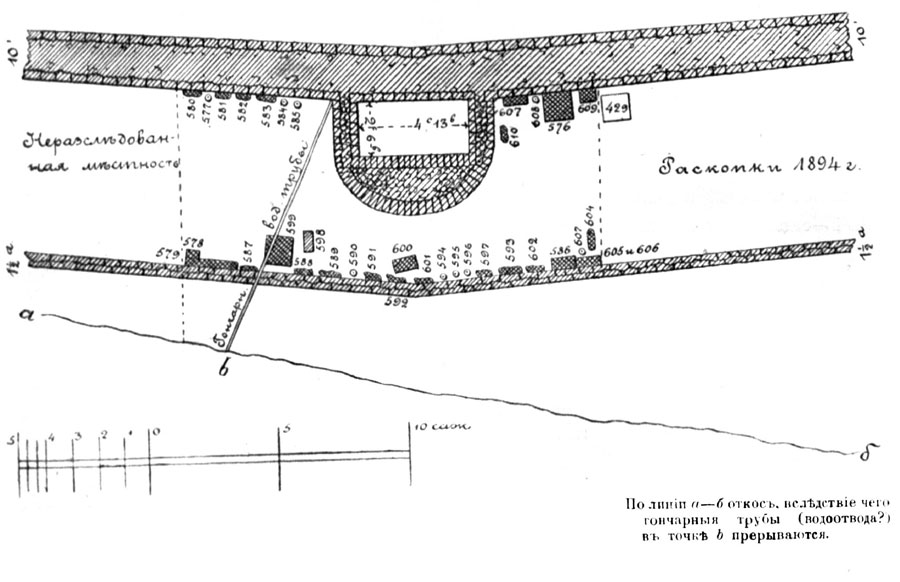
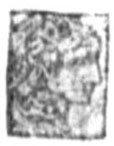


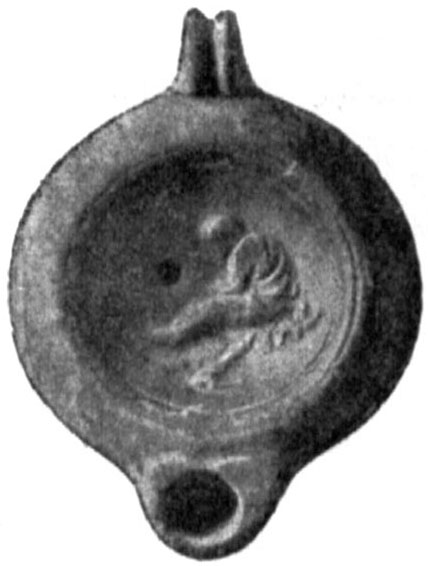

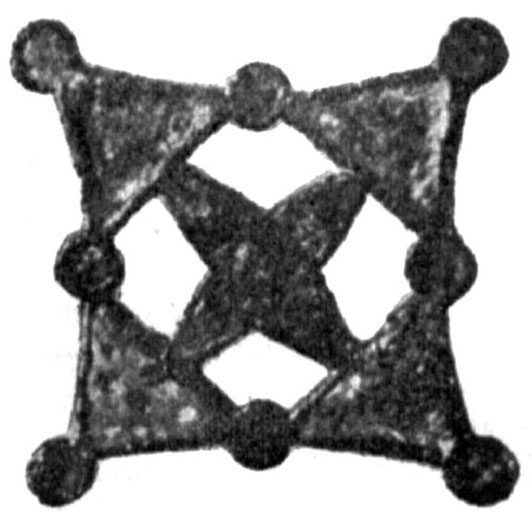


 ;
two of the same form, without names, and two in the form of double-handled pointed-bottom amphorae). The urns, apart from the cremated bones, contained: 3 gl<ass> balsamaria; chisel<ed> bone box (cr<ushed>); 2 iron knife blades; 2 pieces of thin sheet gold, and br<onze> belt buckle. In between of the urns there were: tetrahedral earthen<ware> bottle, of rough workmanship; 3 plain earthen<ware> lamps (one of these have monogram on the bottom); 3 earthen<ware> lamps with rel<ief> images, of bull running to the right on the first
(
;
two of the same form, without names, and two in the form of double-handled pointed-bottom amphorae). The urns, apart from the cremated bones, contained: 3 gl<ass> balsamaria; chisel<ed> bone box (cr<ushed>); 2 iron knife blades; 2 pieces of thin sheet gold, and br<onze> belt buckle. In between of the urns there were: tetrahedral earthen<ware> bottle, of rough workmanship; 3 plain earthen<ware> lamps (one of these have monogram on the bottom); 3 earthen<ware> lamps with rel<ief> images, of bull running to the right on the first
( pressed on the bottom of the second;
wreath of vine leaves
(
pressed on the bottom of the second;
wreath of vine leaves
(
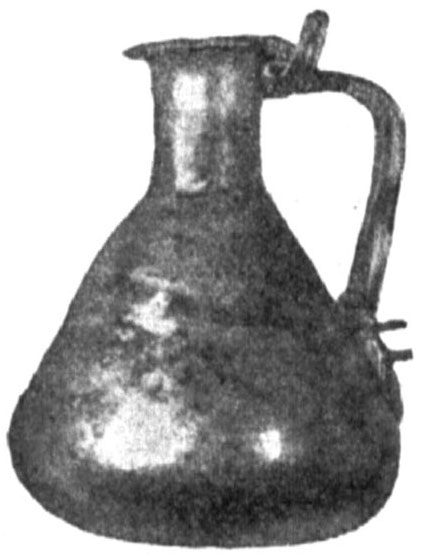
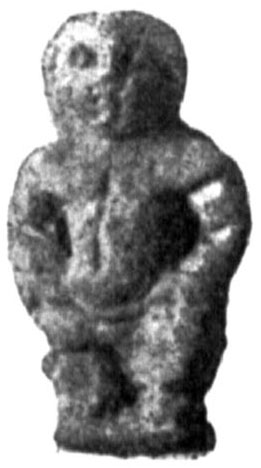
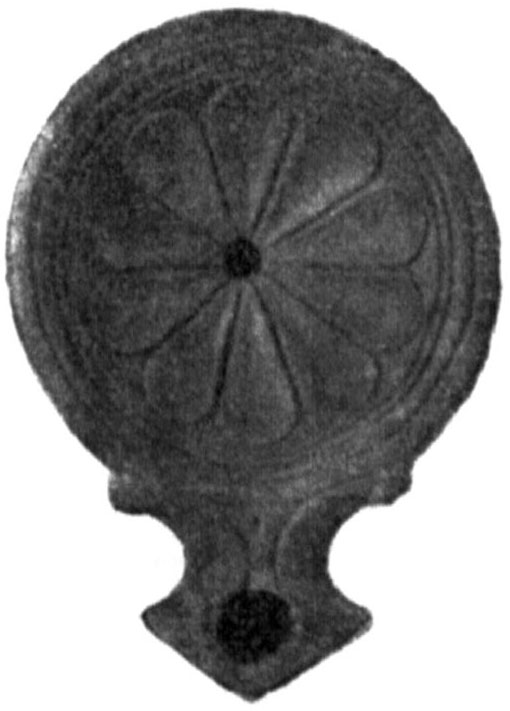
 , that remained on one fragment. Above, there was child's skeleton accompanied with 28 gl<ass> beads scattered on the ground. At the head of the buried person, there was red clay vessel in the form of handleless pot, that contained cremated bones, round-bottom bottle and br<onze> ring. On the bottom of the tomb, there was adult man's skeleton, at the head of which there was black slip earthen<ware> plate and 26 l<ead> three-fingered hands, with hook above, that are often found in tile tombs. This tomb definitely proves that those who lived in the Roman period used the ancient Greek burials that had been constructed before, as well as and more convenient and spacious catacombs.
, that remained on one fragment. Above, there was child's skeleton accompanied with 28 gl<ass> beads scattered on the ground. At the head of the buried person, there was red clay vessel in the form of handleless pot, that contained cremated bones, round-bottom bottle and br<onze> ring. On the bottom of the tomb, there was adult man's skeleton, at the head of which there was black slip earthen<ware> plate and 26 l<ead> three-fingered hands, with hook above, that are often found in tile tombs. This tomb definitely proves that those who lived in the Roman period used the ancient Greek burials that had been constructed before, as well as and more convenient and spacious catacombs.
